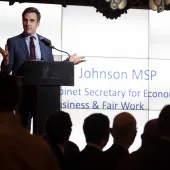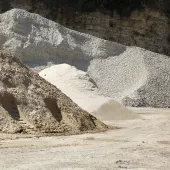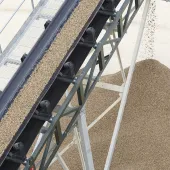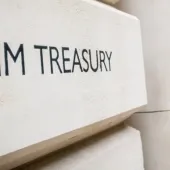Aggregates Tax – The Final Countdown
QPA economist, Jerry McLoughlin, looks back over the tax debate and assess the current situation
In July 1997 the first Budget of the new Labour government kicked off the process which will culminate in the implementation of the aggregates tax from I April 2002. The tax is officially referred to as a 'levy', which sounds much nicer, of course, to those who think such political spin actually fools anyone. But it is a tax - pure and simple. Actually not so pure and simple, and its worth recalling why.
Back in those uncynical times of 1997, a green tax was meant to be a green tax. The
Government's tests of good environmental taxation included the following conditions: '..environmental taxation must meet the general tests of good taxation. It must be well designed, to meet its objectives without undesirable side effects . . .'
The slippery slope towards taxation started when the Government decided that it would not instigate a review of aggregates impacts and policy by issuing a consultation paper setting out potential aims and objectives, and reviewing the means of achieving these. Rather, it decided to use the aggregates sector as a guinea pig for a controversial form of analysis called 'contingent valuation'. This process would produce a monetary valuation of the environmental impacts of aggregates supply, providing a magic number to base a new tax on. The first contingent valuation study, based upon seven quarries, produced an average environmental cost per tonne of £4.60 However, some of the assumptions and analyses made were clearly absurd. One saving grace was that the project had a steering group with members from a range of interests, including the QPA, so that as the work unfolded, the problems were apparent to everyone.
However, when a peer review confirmed that the research valuations were not a reasonable base for taxation, what did the Government do? Did it decide to have an open and transparent review of policy options? Did it decide to assess the actual environmental impacts of aggregates supply? No, it decided to have a much bigger contingent valuation study (costing some £400,00 on top of the £100,000 already spent), and to avoid the distressing possibility of unwelcome questions it was decided to supervise the project with a steering group which excluded representation from the quarrying industry. Rather than dwell upon the manifold problems associated with this second research project, suffice it to say that the research actually indicated that relatively few local residents quoted an environment cost. But in the world of contingent valuation a small number can rapidly become a big one. Hence an environmental cost of some £38 million.
Having established a monetary justification for aggregates tax, what would the Government do? On the basis that it might want to do the right thing environmentally, the QPA put forward a package of environmental proposals as an alternative to the tax. The Association commissioned the UK'S leading environmental economist to assess the environmental merits of the QPA proposals vs the tax. He concluded that: 'an aggregates tax is an extremely inefficient way to try to secure an environmental target: (a) because the demand is inelastic, and (b) because the tax is a products tax rather than an externality tax. This suggests that a package of measures directly targeted at the environmental impacts will be more effective than an aggregates tax'.
Rather than seeing the QPA proposals (or a development of these proposals) as an environmental opportunity, however, some in government, and elsewhere, were continually looking for reasons to undermine rather than develop the concept, with the end result that the Treasury rejected the opportunity to work with industry, rejected partnership and decided to introduce an aggregates tax. There is a depressing logic to this, of course. If you are a senior policy type in Government, the trouble with a partnership is that you actually have to do something. The trouble with a real environmental initiative is that you have to work at it. It is so much easier to introduce a tax. It looks good in the Budget - another green gesture, it puts the issue into the out tray, and it introduces another revenue stream for the Government. You then ring up your colleagues in Customs and Excise and tell them to sort out the legislation and collect the money.
Which brings things neatly to the situation today. The tax is looming and both Customs and Excise and industry are frantically trying to sort out the theory and practice of implementation. Meanwhile, the Treasury sits in Parliament Street doing the three wise monkeys routine, pretending everything is just dandy. 'Implementation difficulties' they say, 'what nonsense . . . you quarrying chaps have known about the tax for years; the tax will be implemented on 1 April and please don't bother us with such trifling issues as late and inadequate official tax guidance and the fact that necessary regulations have yet to be laid before parliament. Now, Sir Humphrey, pass me the speech about reducing the burdens on business . . .'
Cynicism aside, the QPA and its members have lobbied hard against the tax for four years. An environmentally more efficient alternative to the aggregates tax has been proposed and clear justification for an implementation delay has been demonstrated.
From the Government's point of view, no method has yet been published as to how the environmental impact of the tax will be assessed. There are lots of general assertions to 'justify' the tax, but nothing more. The Government has now been forced to acknowledge that the UK aggregates tax will be at least four times higher than any equivalent taxes elsewhere in Europe, in spite of the UK quarrying industry's environmental performance being the best in Europe. But this is not an area where government wishes to see policy development tainted by facts.
Unfortunately, at this stage in the process, the only rational expectation is that the aggregates tax will be implemented from 1 April 2002. In the real world of business, customers, and tax liability, all quarry operators will have received aggregates tax registration documents from Customs and Excise together with associated tax guidance.
Although there are outstanding issues to resolve about omissions from the guidance and problems of interpretation, the 'default' position for operators is clear. All rock and sand and gravel will be liable to the tax unless the process applied to the aggregate/end use is specifically exempted or relieved from tax. In broad terms, conventional construction uses of rock and sand and gravel will be taxed, and a range of industrial and agricultural uses will be exempted or relieved. Customers will only be able to claim tax reliefs/exemptions if they present certificates to the quarry operators setting out the basis for the relief/exemption. If this evidence is not available (or not convincing!) the operators will not be able to allow the relief. If a customer fraudulently claims a relief, and the operator has demonstrated a reasonable duty of care in allowing the relief,
Customs and Excise have indicated that they will be prepared to chase the customers to recover the tax and take appropriate legal action.
The QPA is trying to clarify outstanding issues. Customs and Excise, for example, have just responded with more detailed guidance on tax points and liability with regard to the supply of marine aggregates. The Association is also in discussion with the Office for National Statistics to try to ensure that two sets of aggregates price indices are produced in future - one including and one excluding the aggregates tax effect, in order to allow commercial and royalty agreements using price index movements to have appropriate post-tax price indices.
These practical points are all moving targets - between the time this article is written and circulated to readers there will have been further developments regarding the implementation detail of the tax, notably the publication of the further regulations required within the legislation.
If contact has not already been established, it would be prudent for operators to make contact with Customs and Excise officials as soon as possible to discuss tax liabilities and assessment. Methods for the tracking and auditing of taxable aggregates volumes can vary from site to site, depending on the nature of the operation. Arrangements will have to be made, for example, which satisfy Customs and Excise with respect to the identification of taxable aggregates used in value-added processes. Early contact with Customs and Excise on such matters will help to establish if there are issues on which there is some disagreement between the operator and Customs and Excise. The QPA is concerned about the potential for inconsistency in interpreting tax implementation issues amongst different Customs and Excise inspectors, and the best way of resolving such problems is to identify them early.
This leaves the issue of the tax cost. The tax is a cost imposed upon quarry operators. There is no transparent pass through of the tax as with VAT, and some customer ignorance of the tax is apparent. How operators deal with the commercial consequences of the tax cost is an issue for individual operators.
No doubt when customers and clients see the tax cost reflected in market prices, they will reflect upon, and be reassured by, the tax principle set out by the Chancellor in the March 2000 Budget. 'An aggregates levy will ensure that the environmental impacts of aggregates production not already addressed by regulation are more fully reflected in prices'.
In essence, the aggregates tax is a construction tax which the aggregates industry must pay and administer. In spite of the best efforts of trade associations such as the QPA and individual companies to publicize the issue and warn customers and clients of the implications of the tax, in many cases the penny is not going to drop with customers until the tax cost firms into real money. Dealing with this issue is a massive commercial issue for all aggregates businesses.








